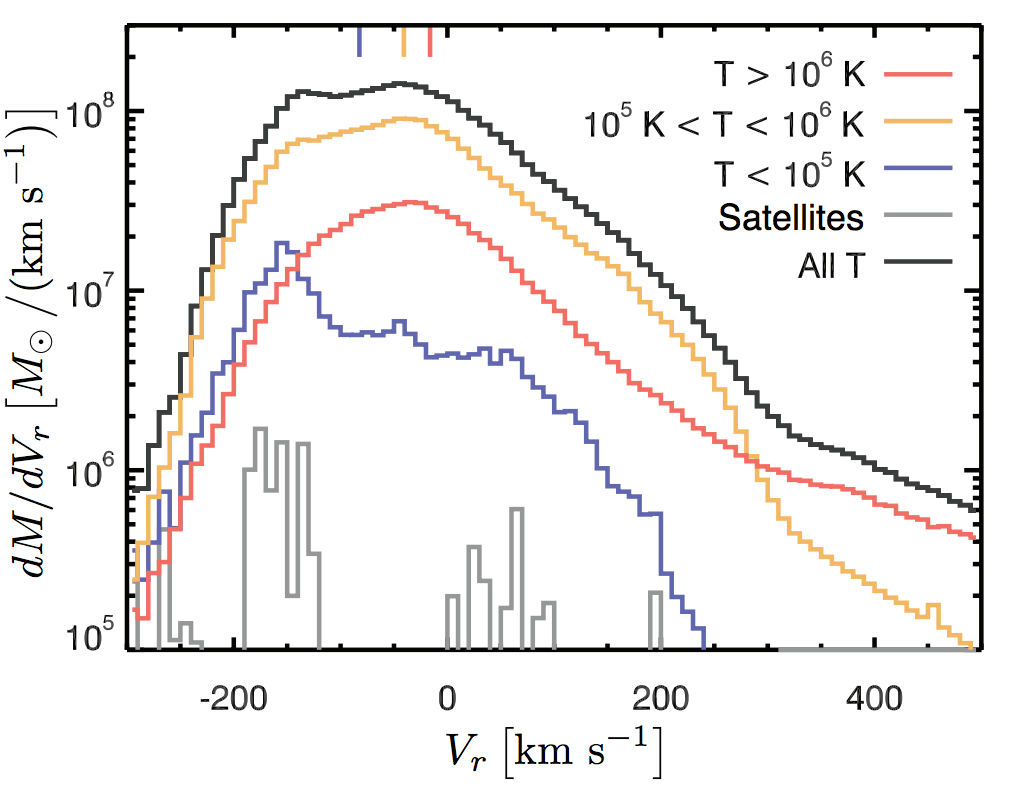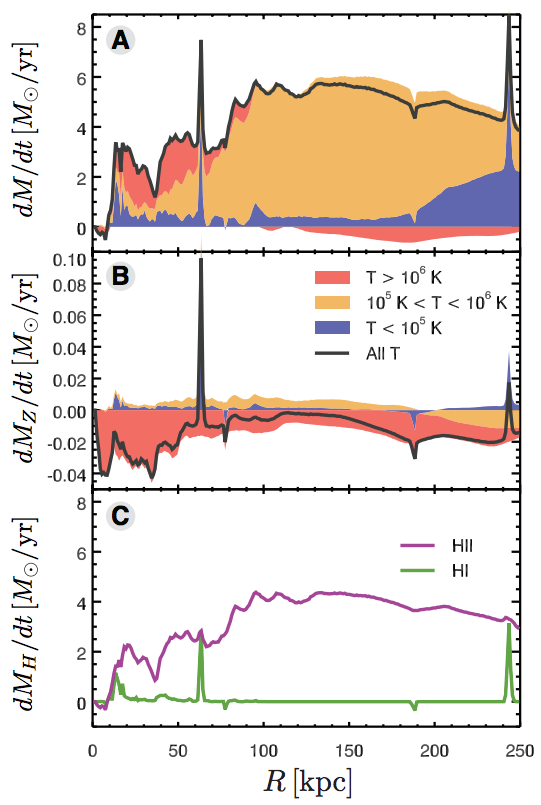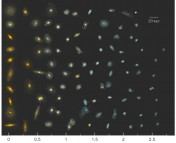- Title: Gas Accretion is Dominated by Warm Ionized Gas in Milky Way-Mass Galaxies at z~0
- Authors: M. Ryan Joung, Mary E. Putnam, Greg L. Bryan, Ximena Fernández, and J. E. G. Peek
- First Author’s Institution: Department of Astronomy, Columbia University
For a long time the Milky Way and other galaxies were thought of as island universes – totally isolated systems of gas, dust, and stars that cannot be perturbed by outside forces. While interacting galaxies provide a violent counterpoint to this point of view, even lines of evidence from our own Galaxy imply that the Milky Way is not as isolated as once thought. Given the Milky Way’s star formation rate of about one solar mass per year, the gas content of the Galaxy is puzzlingly small: only 109 solar masses. If one assumes that the Milky Way will continue to form stars at one solar mass per year, this implies that the Galaxy should run out of gas in about a billion years – a relatively short timescale compared to the age of the universe. In fact, observations of stars with known trigonometric distances in the Hipparcos catalogue imply that the Milky Way has been steadily forming about one solar mass of stars per year for the past several billion years. Either we happen to be living in the epoch when the Milky Way is about to run out of gas or the Milky Way must still be accreting a significant amount of gas from the intergalactic medium.

Figure 1: The differential distribution of gas in the halo of the simulated galaxy as a function of the radial velocity of the gas.
But where is this gas? While there is a large reservoir of gas in the high-velocity clouds of atomic hydrogen in the Milky Way’s halo, it turns out that they can only supply about 0.1 solar mass per year of gas: not enough to keep the Milky Way well fed for the foreseeable future. It may be that hot x-ray emitting gas can cool onto the disk – but the time for this cooling process to occur is longer than the age of the universe, implying that hot gas cannot efficiently feed the Milky Way. While the known gas in the Milky Way’s halo cannot supply enough gas to fuel star formation, what about the gas we haven’t observed yet? There may be a significant undetected reservoir of ‘warm’ ~105 K gas. This gas is particularly challenging to detect since it should be largely diffuse and ionized – not dense enough to produce appreciable emission in recombination lines like Hα and not hot enough to emit in X-rays.
This brings us to today’s astrobite: an analysis of a simulated Milky Way in which the gas supply mostly consists of warm gas with a temperature of a few times 105 K. Using a high-resolution cosmological simulation of the formation of a Milky Way mass halo that was evolved all the way to redshift zero – an extremely computationally intensive task – the authors perform a detailed analysis of the gas in the halo of the galaxy. The halo – defined as a spherical region with a radius of 250 kpc centered on the dense gas in the disk of the galaxy – contains significant quantities of cold, warm, and hot gas. Since the authors focus on the halo gas, they remove a cylinder containing the Galaxy’s disk from the analysis and work in the frame of the dense gas at the center of the halo to directly measure the relative motion of gas with respect to the Galaxy.
The main result of this analysis is shown in Figure 1 above. Here, the authors plot the mass in gas that is falling in or escaping from the galaxy as a function of the radial velocity of the gas. Gas with a negative radial velocity is infalling gas that will eventually accrete onto the central galaxy. Gas with a positive radial velocity is outflowing gas launched from the sites of supernova explosions. The black curve corresponds to all of the gas in the galaxy halo, while the red, yellow, and blue curves correspond to hot, intermediate, and cool gas, respectively. The gray curve shows the negligible contribution from gas in infalling satellite galaxies. Clearly, gas at intermediate temperatures dominates the infalling gas with Vr < 0. However, this analysis only shows that gas at intermediate temperatures dominates the inflowing gas, not that there is a net accretion of warm gas.

Figure 2: The mass accretion rate as a function of radius for all of the gas (top), only the heavy elements (middle), and for atomic and ionized hydrogen only (bottom).
Thankfully, it is relatively straightforward to estimate the mass accretion rate at a given radius by calculating the flux of matter through spherical shells surrounding the galaxy. At any given point on the surface of a sphere surrounding the galaxy the gas may have a net positive or negative velocity. By doing a mass weighted sum of all of the gas at a given radius, the authors calculate the mass flux through the shell. It’s straightforward to generalize this calculation to a large number of shells and the results of this new analysis are shown at right where the mass accretion rate is plotted as a function of the radius of the spherical shell under consideration. At top, the authors plot the accretion rate for all gas as well as the accretion rate for different temperature bins. A positive mass accretion corresponds to new inflow of gas at that radius while a negative accretion rate corresponds to net outflow of gas at a given radius. As in Figure 1, red corresponds to hot gas, yellow to warm gas, and blue to cool gas. Clearly, gas at intermediate temperatures dominates the accretion at almost all radii, with a significant contribution from a satellite galaxy at 60 kpc and hot gas from 20 to 40 kpc. The middle panel is also quite interesting – showing that the metal content of the halo is outflowing at almost all radii and that the most of the metals live in hot x-ray emitting gas. This gas was probably launched in supernova explosions.
This new simulation shows that the mystery of the Milky Way’s gas supply may not be so mysterious after all: it is extremely difficult to detect warm ~105 K gas. In the future we may be able to directly detect this gas using sensitive observations of far ultraviolet emission lines of Oxygen and Carbon but these observations must be done from space and probably require a telescope with a much larger mirror than Hubble’s. We may have a better chance of detecting this gas today with the Cosmic Origins Spectrograph on HST by finding a sightline toward a bright background source that shows absorption in the same FUV emission lines. Unfortunately, this may prove to be difficult: the authors estimate that the warm infalling gas only covers 20% of the sky implying that finding a sightline for studies of this gas may be difficult.





What about looking for free-free emission or (assuming some magnetic fields) Faraday rotation effects for this ionized gas at 10^5 K
It’s funny you mention that since there’s a paper on the arxiv today that uses just such emission, along with measurements of O VII absorption to probe similar gas with T ~ 10^6 K.